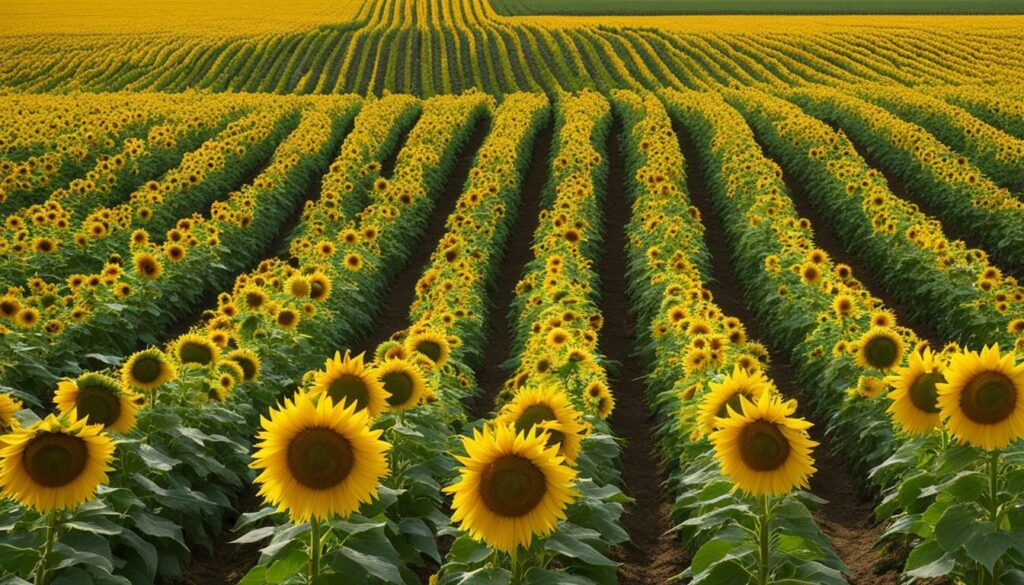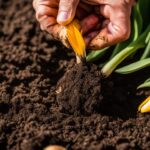Welcome to the world of Date Semis Tournesol, where we explore the best strategies for planting and cultivating sunflowers in France’s unique climate. In this section, we will focus on the optimal times for seeding sunflowers, emphasizing the importance of proper planting and cultivation techniques for successful sunflower growth.
Planting sunflowers in France’s unique climate requires careful consideration of timing. By understanding the optimal period for sunflower planting, you can maximize your yields and ensure successful cultivation. Early planting is crucial for achieving higher yields, and we will provide guidance on selecting the best time to seed sunflowers.
When it comes to seeding sunflowers, proper techniques play a crucial role in their growth. We will discuss the recommended seeding techniques, including planting density and spacing, for optimal sunflower cultivation. Adjusting seeding speed and depth will also be covered to ensure an even distribution of seeds.
Proper soil preparation is key to creating the ideal conditions for sunflower growth. We will guide you through the necessary steps to prepare the soil, ensuring that it provides the nutrients and structure necessary for sunflowers to thrive.
In sunflower fields, effective weed management is essential. We will delve into the importance of managing weeds to protect your sunflower crop and provide strategies for effective weed control.
Pests can pose a threat to sunflower cultivation, and we will discuss the importance of pest control. By understanding common pests and implementing effective management techniques, you can safeguard your sunflower plants and ensure their healthy growth.
Disease prevention and management are vital for successful sunflower cultivation. We will highlight common diseases that can impact sunflowers and provide strategies for disease prevention and control, helping you maintain a healthy crop.
Maximizing sunflower yield requires careful attention to various factors. We will explore techniques to optimize sunflower growth and productivity, ensuring that you achieve the highest possible yield.
Once your sunflowers are ready for harvest, proper techniques are crucial for success. We will cover the optimal time for sunflower harvest, efficient harvesting techniques, and proper storage of sunflower seeds for future use.
Finally, we will provide insights into the sunflower market and its various uses. Sunflowers have economic value in different industries, and understanding their market significance can further enhance your sunflower cultivation knowledge.
In conclusion, Date Semis Tournesol offers valuable information and guidance on planting and cultivating sunflowers in France’s unique climate. By implementing the best strategies discussed in this article, you can ensure successful sunflower growth and reap the rewards of a bountiful harvest.
Understanding Sunflower Planting Times
When it comes to sunflower planting, timing is everything. Discover the optimal period for seeding sunflowers and unlock the potential for higher yields in your sunflower fields. In France, the unique climate offers favorable conditions for sunflower cultivation, but it’s crucial to understand the best time to start planting.
According to experts, the ideal period for sunflower planting in France is from late April to mid-May. Planting sunflower seeds during this time allows for early establishment and growth, leading to higher yields. Early planting takes advantage of the longer daylight hours and warmer temperatures, giving sunflowers a head start in their growth cycle.
To maximize your sunflower yield, it’s important to consider factors such as soil temperature and frost risk. Sunflower seeds require a soil temperature of at least 50°F (10°C) for successful germination. By starting your sunflower planting during the optimal period, you can ensure that the soil has reached the necessary temperature for seedling development.
By following these guidelines for sunflower planting times, you can set the stage for a productive sunflower harvest. Remember to adjust your planting schedule based on the specific conditions of your region and consult with local agricultural experts for personalized recommendations.
Table 1: Optimal Sunflower Planting Times in France
| Region | Optimal Planting Period |
|---|---|
| Western France | Late April to early May |
| Central France | Mid to late April |
| Eastern France | Early to mid-April |
Seeding Techniques for Sunflowers
Effective seeding techniques are essential for successful sunflower cultivation. Learn how to achieve optimal growth by understanding the right planting density, spacing, and adjustments for seeding speed and depth.
When it comes to planting sunflowers, the recommended planting density is typically 20,000 to 30,000 plants per acre. This allows for adequate space for each plant to grow and develop. It is important to evenly distribute the seeds to ensure uniform growth throughout the field. Adjusting the seeding speed and depth can help achieve this.
For ideal spacing between sunflower plants, a row spacing of 30 to 36 inches is commonly recommended. This provides enough room for the plants to receive sufficient sunlight and nutrients for optimal growth. It is advisable to use a precision planter to ensure accurate seed placement and spacing.
Additionally, adjusting the seeding depth is crucial for successful sunflower cultivation. The optimal seeding depth is typically around 1 to 2 inches, depending on soil conditions. Planting too shallow can result in poor seed-to-soil contact, while planting too deep may inhibit germination. It is essential to consider the soil type and moisture levels when determining the ideal seeding depth.
Table: Recommended Seeding Techniques for Sunflowers
| Aspect | Recommended Technique |
|---|---|
| Planting Density | 20,000 to 30,000 plants per acre |
| Spacing | 30 to 36 inches between rows |
| Seeding Depth | 1 to 2 inches, considering soil type and moisture |
By following these recommended seeding techniques, you can increase the chances of successful sunflower cultivation and achieve optimal growth. Remember to monitor the plants regularly throughout their growth stages and make necessary adjustments as needed to ensure healthy development.
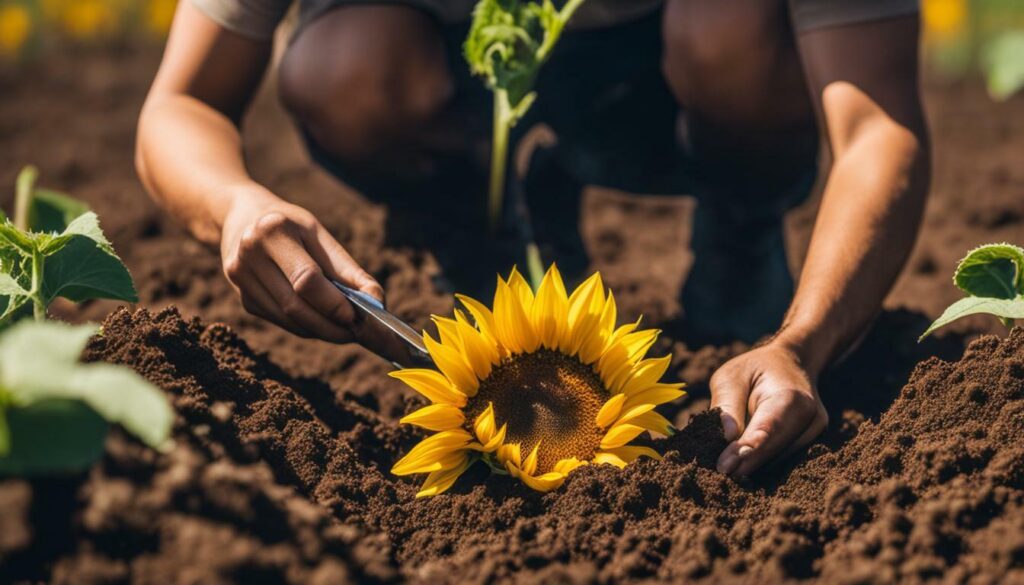
A successful sunflower harvest starts with proper soil preparation. Discover the essential steps for cultivating healthy sunflowers through effective soil preparation techniques. Sunflowers thrive in well-drained soil with a pH level between 6.0 and 7.5.
Start by clearing the area of any existing vegetation, including weeds and debris, to create a clean foundation for planting. This will minimize competition for nutrients and sunlight, allowing the sunflowers to grow unhindered. Avoid using herbicides or chemical weed killers, as these can negatively impact the health of the sunflowers.
Next, loosen the soil to a depth of 10-12 inches using a garden fork or tiller. This will improve drainage and create a loose, friable soil structure that is ideal for sunflower root development. Remove any large rocks or debris as you work the soil to ensure a smooth planting surface.
Soil Amendments and Fertilization
Depending on the nutrient levels in your soil, you may need to amend it with organic matter or fertilizers. Conduct a soil test to determine the pH level and nutrient deficiencies, if any. Based on the results, add organic matter such as compost or well-rotted manure to improve the soil’s fertility and structure.
When fertilizing, use a balanced, slow-release fertilizer that provides essential macronutrients like nitrogen (N), phosphorus (P), and potassium (K). Follow the recommended application rates according to the fertilizer package instructions. Applying too much fertilizer can lead to excessive leaf growth and weak stems, while a deficiency can result in stunted growth and low flower production.
| Macronutrient | Function | Source |
|---|---|---|
| Nitrogen (N) | Stimulates leaf growth and overall plant vigor | Compost, manure, or nitrogen-based fertilizers |
| Phosphorus (P) | Promotes root development and flower production | Phosphorus-rich fertilizers or bone meal |
| Potassium (K) | Enhances overall plant health and disease resistance | Potassium-rich fertilizers or wood ash |
Before planting the sunflower seeds, rake the soil surface gently to create a fine, level bed. This will provide an optimal environment for germination and ensure even sprouting. With the soil properly prepared, your sunflower seeds will have the best chance of thriving and producing beautiful blooms.
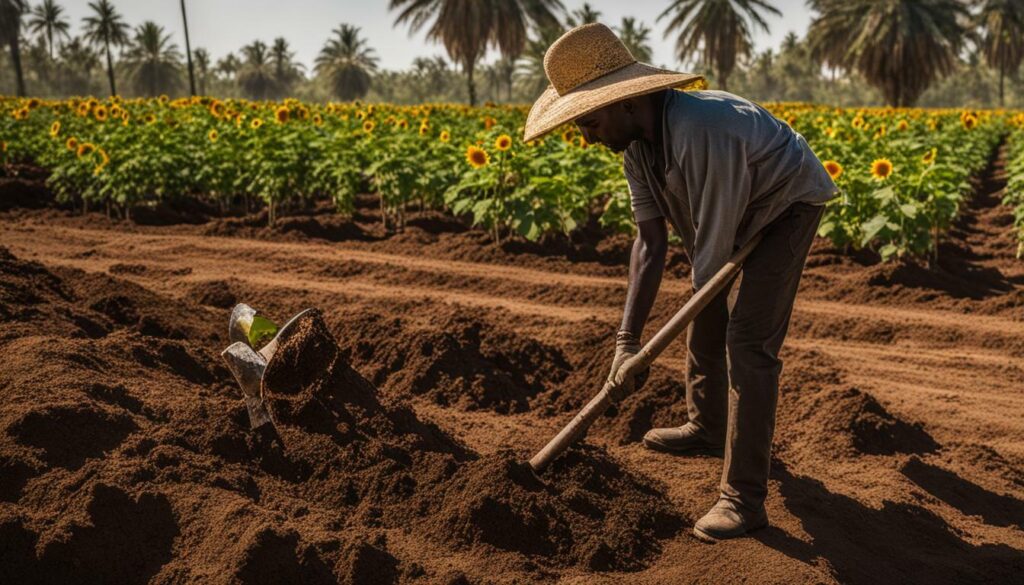
Weeds can wreak havoc on sunflower fields, but with the right management strategies, you can safeguard your crop. Effective weed management is crucial for ensuring the healthy growth and productivity of sunflowers. By implementing proper weed control techniques, you can create an environment that allows sunflowers to flourish and maximize their yield.
One of the key aspects of weed management is understanding the different types of weeds that commonly infest sunflower fields. Identifying these weeds and their growth patterns is essential for developing targeted control methods. Regular monitoring of the field and early intervention can prevent weed growth from becoming a major issue.
There are several effective weed control techniques that you can employ in your sunflower fields. These include mechanical weed removal, such as hand weeding or hoeing, which can be ideal for smaller fields. Mulching is another effective method that helps suppress weed growth by blocking sunlight and reducing weed germination. Additionally, the use of herbicides can be an efficient way to control weeds, but it should be done carefully, following proper dosage and application guidelines.
| Weed Control Techniques | Pros | Cons |
|---|---|---|
| Mechanical weed removal | – Targeted control – Environmentally friendly – Allows for closer inspection of the crop |
– Labor-intensive – Time-consuming |
| Mulching | – Suppresses weed growth – Conserves soil moisture – Regulates soil temperature |
– Initial cost of materials – Requires maintenance |
| Herbicides | – Effective in large-scale weed control – Time-efficient – Wide range of herbicides available |
– Potential environmental impact – Requires careful application – Risk of herbicide resistance in weeds |
Implementing a combination of these weed control techniques can provide optimal results. It’s important to customize your approach based on the specific weed species, field size, and other factors unique to your farming operation. By staying vigilant and implementing effective weed management strategies, you can ensure the success of your sunflower crop.
Image:
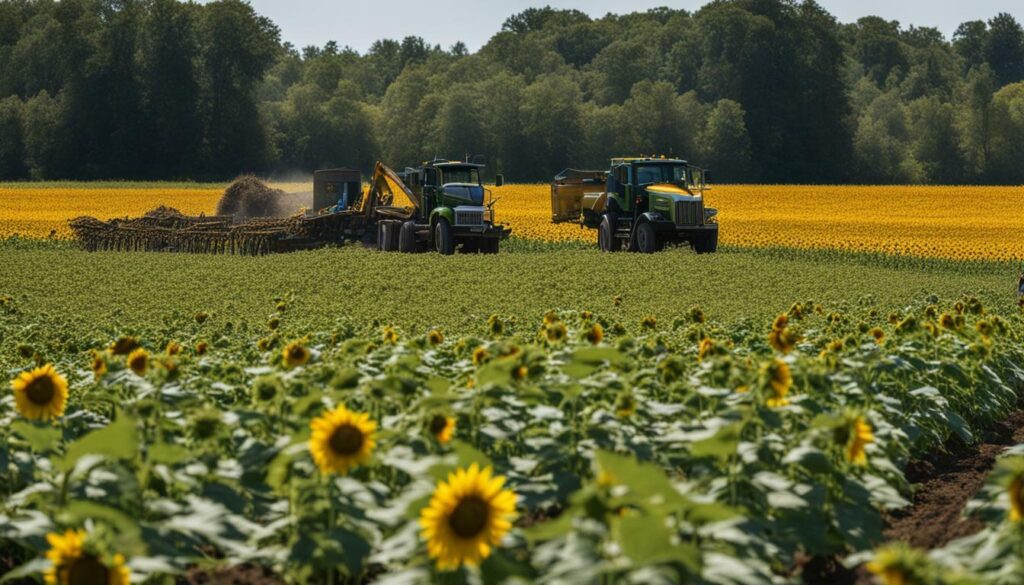
Protecting your sunflower crop from pests is essential for a successful harvest. Learn the best practices in pest control to ensure healthy and robust sunflower plants.
One of the key steps in pest control for sunflower cultivation is prevention. Implementing good agricultural practices, such as crop rotation and maintaining proper field hygiene, can significantly reduce the risk of pest infestations. Regularly inspecting your sunflower plants for early signs of pest activity is vital for early intervention and effective pest management.
When it comes to managing pests in sunflower fields, it is crucial to identify the specific pests that can damage your crop. Some common pests that sunflowers are susceptible to include aphids, cutworms, and sunflower moths. Understanding their life cycles, feeding habits, and preferred habitats is essential for developing targeted pest control strategies.
Integrated Pest Management (IPM) techniques are highly recommended for sustainable and eco-friendly pest control in sunflower cultivation. This approach combines various pest control methods, such as cultural practices, biological control, and the careful use of pesticides when necessary. By adopting IPM, you can minimize the use of chemicals and reduce the impact on beneficial organisms while effectively managing pest populations.
Table: Common Pests in Sunflower Cultivation
| Pest | Description |
|---|---|
| Aphids | Small, sap-sucking insects that can cause stunted growth and deformed flowers. |
| Cutworms | Larvae of moths that feed on the stems of young sunflower plants, causing wilting and death. |
| Sunflower Moths | Adult moths lay eggs on sunflower heads, and the hatched larvae feed on developing seeds, leading to yield loss. |
By implementing effective pest control measures and staying vigilant throughout the growing season, you can minimize the damage caused by pests and maximize the health and productivity of your sunflower crop. Consult with local agricultural experts or extension services for region-specific pest management recommendations to ensure the best results.
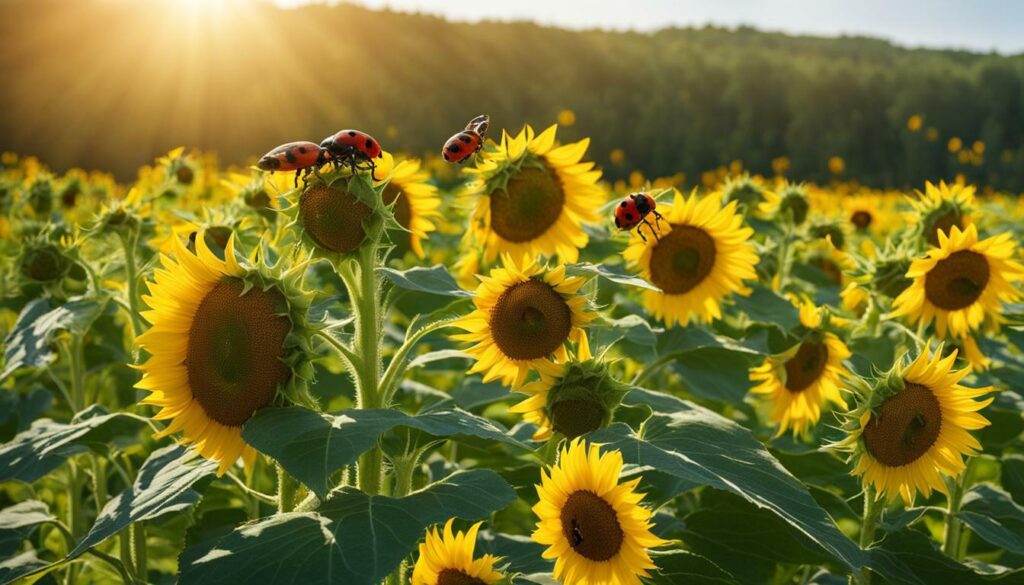
Diseases can threaten the health of your sunflower plants, but with proper management techniques, you can minimize their impact. Discover effective strategies for disease management in sunflower cultivation.
One of the most common diseases that affect sunflowers is powdery mildew, which is caused by a fungus. This disease manifests as a white powdery coating on the leaves, stems, and flowers of the plant. To prevent the spread of powdery mildew, it is crucial to maintain proper spacing between plants for adequate airflow and reduce the humidity around the plants. Regularly monitoring your sunflower plants for any signs of powdery mildew and taking immediate action, such as removing infected leaves or using fungicides, can help control the disease.
Another common disease in sunflowers is downy mildew, caused by a different type of fungus. Downy mildew appears as yellow or light green patches on the upper surface of the leaves. To manage downy mildew, it is essential to remove and destroy any infected plant material. Fungicides can also be used to control the spread of this disease, but it is important to follow the instructions carefully and use them as a last resort.
Table: Common Sunflower Diseases and Management Techniques
| Disease | Symptoms | Management Techniques |
|---|---|---|
| Powdery Mildew | White powdery coating on leaves, stems, and flowers | – Maintain proper spacing for airflow – Remove infected leaves – Use fungicides if necessary |
| Downy Mildew | Yellow or light green patches on leaves | – Remove and destroy infected plant material – Use fungicides sparingly |
It is also essential to implement good cultural practices to reduce the risk of disease in sunflowers. This includes practicing crop rotation, as certain diseases can persist in the soil. Additionally, avoiding excessive nitrogen fertilization and providing adequate water and nutrition to the plants can help promote their overall health and make them less susceptible to diseases.
By being proactive in disease management and following these strategies, you can safeguard your sunflower crop and ensure the successful growth of your plants.
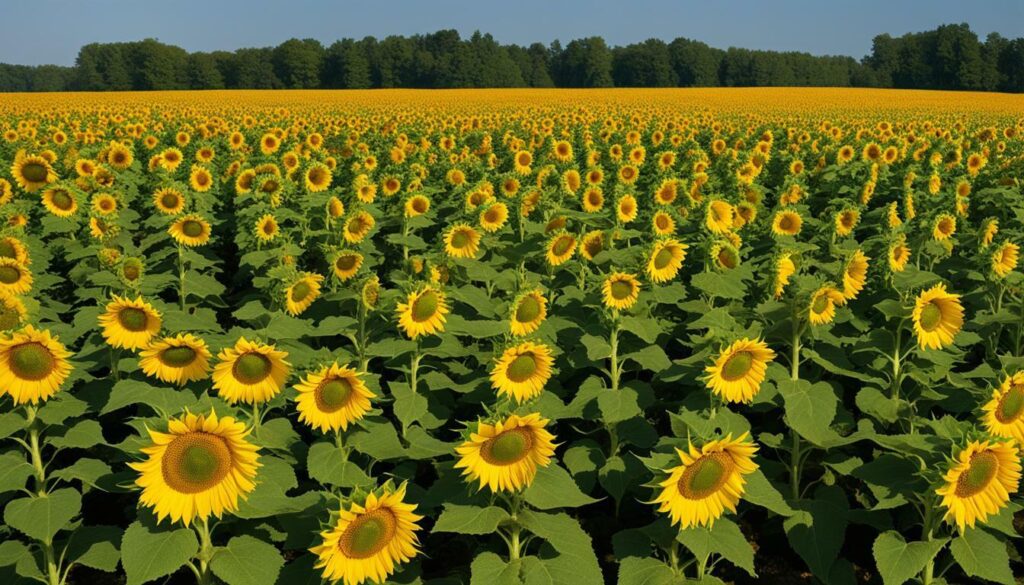
Unlock the secrets to maximizing your sunflower yield with proven techniques that promote optimal growth and abundant harvests. To achieve high-yield sunflower cultivation, it is essential to implement strategies that optimize sunflower growth from the moment of planting. By paying attention to crucial factors such as planting density, soil preparation, and weed management, you can set the foundation for a successful sunflower crop.
Planting Density and Spacing
One of the key factors in maximizing sunflower yield is proper planting density and spacing. By carefully selecting the number of seeds to sow per unit area, you can ensure optimal sunlight, nutrients, and water availability for each plant. This promotes healthier growth and reduces competition among sunflowers. Aim for a planting density of around 20,000 to 25,000 plants per hectare, with spacing between plants of approximately 30 to 40 centimeters. These guidelines provide the ideal balance between plant growth and yield potential.
Soil Preparation for Optimal Growth
Before sowing sunflower seeds, it is crucial to prepare the soil adequately to provide the optimal conditions for growth. Start by removing any weeds and debris from the planting area to minimize competition for nutrients. Additionally, ensure the soil is well-drained and has a pH level between 6 and 7, which is optimal for sunflower cultivation. Incorporating organic matter such as compost or well-rotted manure can improve soil fertility and moisture retention. This sets the stage for healthier root development and overall plant vigor.
Weed Management for High-Yield Sunflower Cultivation
Effective weed management is essential to maintain the health and productivity of sunflower fields. Weeds compete with sunflowers for resources, leading to reduced yields and potential crop damage. Implement a comprehensive weed control strategy that includes cultural practices such as regular cultivation, mulching, and timely removal of weeds. Additionally, consider using herbicides selectively and in accordance with local regulations to target specific weed species while minimizing environmental impact. By managing weeds effectively, you can ensure that your sunflowers have the best chance of reaching their full yield potential.
Complete Table:
| Factors | Techniques |
|---|---|
| Planting Density and Spacing | Aim for 20,000 to 25,000 plants per hectare with 30-40 cm spacing between plants. |
| Soil Preparation | Remove weeds and debris, ensure well-drained soil with a pH of 6-7, incorporate organic matter. |
| Weed Management | Implement cultural practices, such as cultivation and mulching, remove weeds timely, consider selective herbicide use. |
Unlock the potential of your sunflower crop by implementing these proven techniques for maximizing sunflower yield. With careful attention to planting density, soil preparation, and weed management, you can create the perfect environment for optimal sunflower growth and abundant harvests.
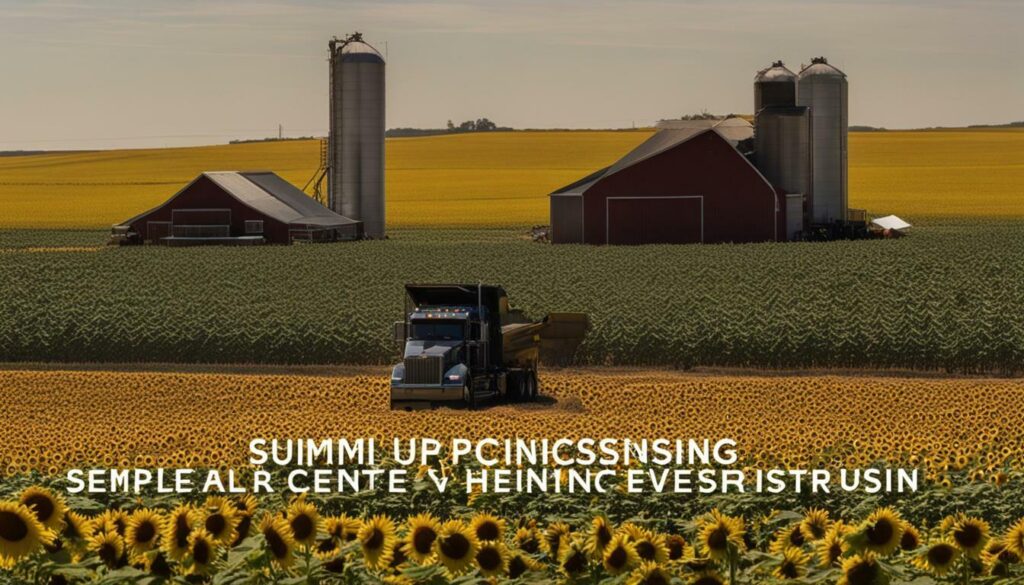
A successful sunflower harvest is the culmination of meticulous planning and precise execution. Learn the art of harvesting sunflowers to ensure a bountiful yield and high-quality seeds. To begin, it is essential to harvest sunflowers when they have reached their optimal maturity. Look for signs of maturity such as fully developed petals, yellowing of the back of the sunflower head, and drying of the seeds. Harvesting too early can result in immature seeds with low oil content, while delaying the harvest may lead to seed shattering and loss.
When it comes to harvesting techniques, there are two main methods: hand harvesting and mechanical harvesting. Hand harvesting is suitable for small-scale operations or when seed quality is of utmost importance. To hand harvest, cut the sunflower heads using sharp shears or a knife, leaving a long stem for easy handling. Hang the sunflower heads upside down in a well-ventilated area to dry completely before extracting the seeds.
On the other hand, mechanical harvesting is a more efficient option for larger-scale sunflower farms. Mechanical harvesters are designed to cut and gather the sunflower heads in one swift motion. Once the sunflower heads are harvested, they are transported to a drying facility where the seeds are separated from the heads using specialized equipment. This method allows for higher productivity and faster processing.
| Harvesting Technique | Advantages | Considerations |
|---|---|---|
| Hand Harvesting | – High seed quality – Suitable for small-scale operations – Selective harvesting |
– Labor-intensive – Time-consuming – Limited capacity |
| Mechanical Harvesting | – High productivity – Efficient for large-scale operations – Faster processing |
– Potential seed damage – Initial investment in equipment – Less selective harvesting |
Once the seeds have been extracted, it is vital to store them properly to maintain their quality and viability. Sunflower seeds should be stored in a cool, dry, and well-ventilated place to prevent moisture absorption and mold growth. Using airtight containers or bags can help preserve the seeds’ freshness and protect them from pests. Regular monitoring of the stored seeds is recommended to detect any signs of deterioration or infestation.
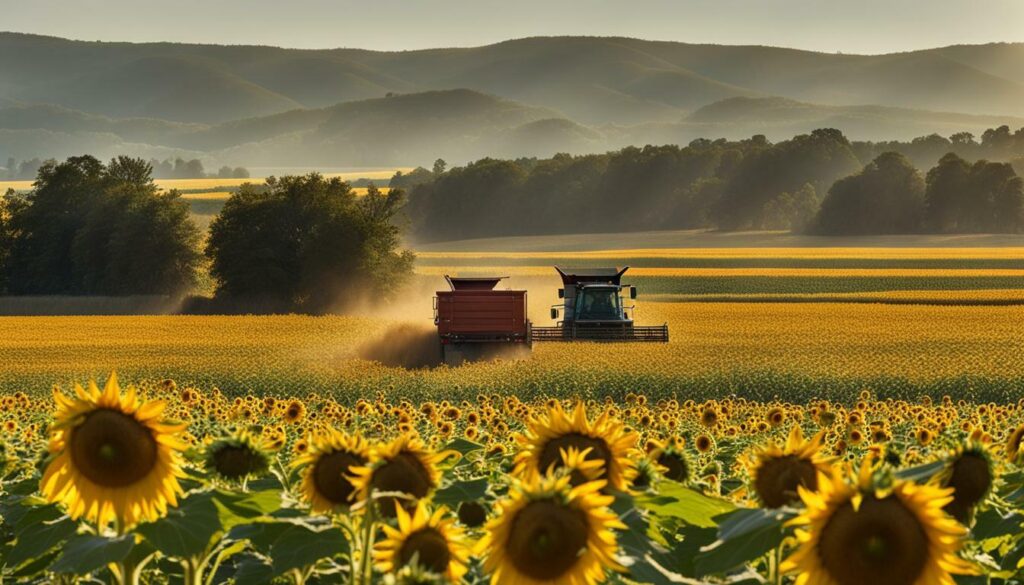
Mastering the art of harvesting sunflowers is crucial for a successful harvest and the production of high-quality sunflower seeds. Whether you choose to hand harvest or opt for mechanical harvesting, ensuring proper maturity, and following the appropriate techniques will help maximize your yield and secure a valuable crop. With diligent care and attention to detail, you can enjoy the rewards of your sunflower harvest and contribute to France’s vibrant sunflower industry.
Sunflower Market and Uses
Sunflowers are not only beautiful, but they also hold immense value in various industries. Explore the diverse market and uses of sunflowers that make them a valuable crop. From their bright yellow petals to their nutrient-rich seeds, sunflowers have captured the attention of people worldwide.
The market for sunflowers is vast and ever-growing. Sunflower oil, extracted from the seeds, is a popular cooking oil known for its light flavor and high smoke point. It is used in a wide range of culinary applications, including frying, baking, and salad dressings. Sunflower oil is also used in the production of margarine and other food products.
Aside from their culinary uses, sunflowers have found their way into the beauty and skincare industry. The oil extracted from sunflower seeds is rich in vitamins and antioxidants, making it a sought-after ingredient in skincare products such as moisturizers, serums, and hair care formulas. It nourishes the skin, promotes elasticity, and provides protection against environmental damage.
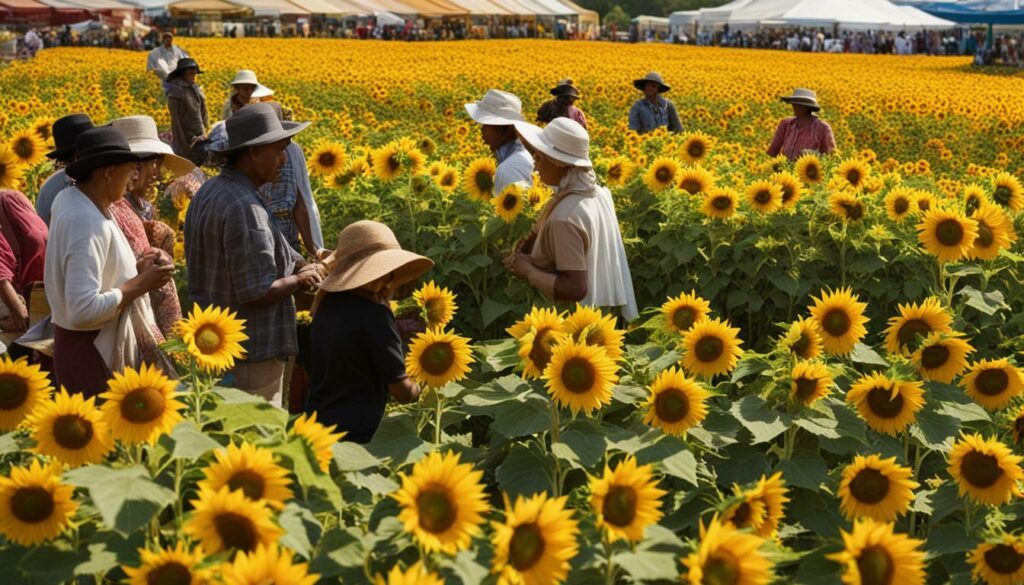
| Industries | Uses of Sunflowers |
|---|---|
| Food | Cooking oil, margarine, salad dressings |
| Beauty and Skincare | Moisturizers, serums, hair care products |
| Animal Feed | Poultry, livestock, and pet food |
| Biofuel | Renewable energy source |
Sunflowers are also widely used in the animal feed industry. The high-quality protein content in sunflower meal makes it an ideal supplement for poultry, livestock, and pet food. It provides essential nutrients and promotes healthy growth and development in animals.
Furthermore, sunflowers have gained importance in the renewable energy sector. The seeds can be processed to produce biodiesel, a clean-burning alternative to fossil fuels. Sunflower biodiesel reduces greenhouse gas emissions and contributes to a more sustainable future.
The market and uses of sunflowers continue to expand, with new applications being discovered. Whether it’s in the kitchen, the beauty aisle, the farm, or the energy sector, sunflowers have proven to be a versatile and valuable crop with a bright future ahead.
Conclusion
In conclusion, Date Semis Tournesol guides you through the optimal strategies for planting and cultivating sunflowers in France’s unique climate, ensuring successful sunflower growth through well-executed techniques. By understanding the best times for sunflower planting and the benefits of early seeding, you can achieve higher yields and maximize your sunflower crop’s potential.
Proper seeding techniques, such as selecting the right planting density and spacing, play a crucial role in ensuring optimal sunflower growth. Adjusting the seeding speed and depth can help achieve an even distribution of seeds, promoting uniform growth and healthier plants.
Additionally, soil preparation is essential for creating the ideal conditions for sunflower cultivation. By following the recommended steps, you can provide your sunflowers with the necessary nutrients and a suitable environment for robust growth.
Effective weed management, pest control, and disease prevention are also vital aspects of cultivating sunflowers. By implementing suitable strategies to manage weeds, pests, and diseases, you can safeguard your sunflower crop and mitigate potential damage.
Finally, to maximize sunflower yield, it is crucial to harvest the plants at the optimal time and employ efficient harvesting techniques. Proper storage of sunflower seeds ensures their quality and viability for future use.
By following the guidelines provided in Date Semis Tournesol, you can confidently navigate the process of planting and cultivating sunflowers, harnessing France’s unique climate to achieve successful sunflower growth and contributing to the sunflower industry’s economic value.
FAQ
When is the optimal period for planting sunflower seeds?
The optimal period for planting sunflower seeds is recommended to be early in the season for higher yields.
What is the recommended planting density and spacing for sunflowers?
It is suggested to plant sunflowers at the recommended planting density and spacing for optimal growth.
Are there any adjustments to be made for even distribution of sunflower seeds?
Yes, adjustments such as seeding speed and depth may need to be made to ensure an even distribution of sunflower seeds.
How important is proper soil preparation for sunflower cultivation?
Proper soil preparation is crucial for creating the ideal conditions for sunflower growth.
How can weeds be managed in sunflower fields?
Weeds in sunflower fields can be effectively managed through various strategies.
How can pests be controlled in sunflower cultivation?
Effective pest control measures should be implemented to manage pests in sunflower cultivation.
What are some common diseases that can affect sunflower plants?
There are several diseases that can impact sunflower plants, and proper disease management is essential.
What techniques can be used to maximize sunflower yield?
Techniques for maximizing sunflower yield can greatly impact the overall productivity of sunflower cultivation.
What are the considerations for harvesting sunflowers?
Harvesting sunflowers at the optimal time and using efficient techniques are important for a successful yield.
How are sunflowers used in different industries?
Sunflowers have various uses in different industries, contributing to their economic value.
- Comment s’occuper de tulipe? - October 22, 2023
- Tulipe qui se ferme la nuit? - October 22, 2023
- Ou acheter tulipe? - October 22, 2023

